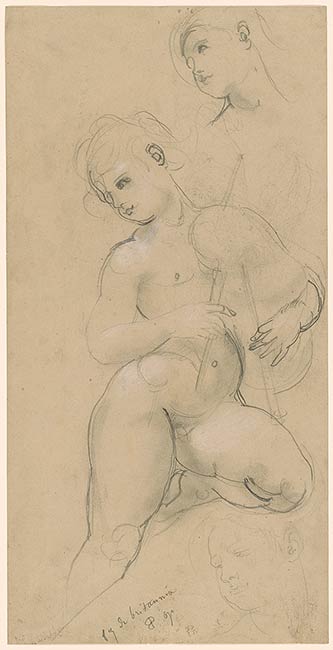

In 1863 Baudry was commissioned by Charles Garnier, architect of the new Paris Opéra house, to decorate the building's entrance hall. Garnier planned for the central section of the vault to be painted, but Baudry proposed a more comprehensive scheme encompassing the entire ceiling.
To prepare, Baudry--a great admirer of Italian art--looked to Renaissance examples. He traveled to Rome to study Michelangelo's Sistine Chapel anew. The project occupied the artist from 1866 until 1874 and yielded three oval ceilings with side panels containing larger-than-life figures of muses and poets. Ten medallions in the long gallery were devoted to personifications of music from different countries, including Persia, Egypt, Greece, Rome, Great Britain, Germany, Italy, France, and Spain, and "barbarian" music. This part of the commission was completed in 1866.
This sheet of studies is preparatory for an oval canvas devoted to the theme of music in Britannia, symbolized by the prominent bagpipe, an instrument particularly associated with the British Isles (see Garnier 1980, pl. 35). Baudry has delineated the largest figure at center, an angel holding the pipes, one knee resting on a cloud, and his gaze directed toward the viewer below. He repeated the head twice, exploring the angle of the angel's face. On the verso are studies for the same figure's right arm and hand, as well as the arm of the angel above him flying away from us into the distance.
Inscribed at lower margin, "foyer (?) britannia / PB (written as a paraph). Op".
Garnier, Charles. "Les Peintures De L'Opéra De Paris : De Baudry À Chagall." Paris: ARTHENA, 1980.
